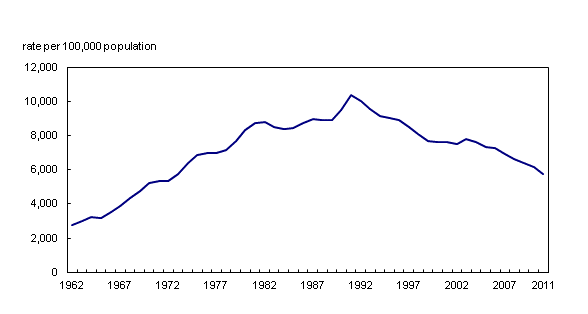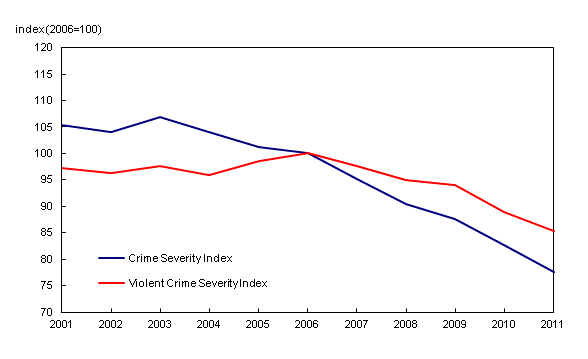Police-reported crime statistics, 2011 (correction)
Archived Content
Information identified as archived is provided for reference, research or recordkeeping purposes. It is not subject to the Government of Canada Web Standards and has not been altered or updated since it was archived. Please "contact us" to request a format other than those available.
Related subjects
-
[an error occurred while processing this directive]
The police-reported crime rate, which measures the overall volume of crime, continued its long-term downward trend in 2011, declining 6% from 2010. The Crime Severity Index, which measures the severity of crime, also fell 6%.
Police-reported crime rate, Canada, 1962 to 2011

Chart description: Police-reported crime rate, Canada, 1962 to 2011
Canadian police services reported almost 2 million Criminal Code (excluding traffic) incidents in 2011, about 110,000 fewer than in 2010.
The drop in crime was seen throughout the country and for most offences, including attempted murders, major assaults, sexual assaults, robberies, break-ins and motor vehicle thefts.
Correction: Offences that showed an increase in 2011 were homicide, sexual offences against children, criminal harassment, impaired driving and most drug offences.
Since it peaked in 1991, the crime rate has generally been decreasing and, in 2011, was at its lowest point since 1972. The Crime Severity Index (CSI) was 26% lower than it was a decade earlier in 2001.
Police-reported crime severity indexes, 2001 to 2011

Chart description: Police-reported crime severity indexes, 2001 to 2011
Violent crime
Police reported over 424,400 incidents of violent crime in 2011, about 14,800 fewer than in 2010. As in previous years, violent crimes accounted for about 1 in 5 offences reported by police.
Both the rate and severity of violent crime fell 4% in 2011. It was the fifth consecutive annual decline in the severity of violent crime.
Despite the overall drop in violent crime, Canada's homicide rate rose 7% in 2011 to 1.7 homicides per 100,000 population. Police reported 598 homicides in 2011, 44 more than in 2010. Despite annual fluctuations, the homicide rate has generally been declining since peaking in the mid-1970s.
The national increase in homicides in 2011 was driven by increases in Alberta and Quebec. Manitoba had the highest homicide rate among the provinces for the fifth consecutive year.
The rate of robbery declined 3% in 2011, continuing a downward trend. Police reported over 29,700 robberies, 700 fewer than in 2010. Rates declined for attempted murder (-3%) and for most types of assault, including sexual assault (-3%).
Increase in sexual offences against children
Police reported more than 3,800 incidents of sexual violations against children in 2011, a 3% increase.
Among the specific offences in this category, the rate of luring a child via a computer rose 10%, while the rate of invitation to sexual touching increased 8%. The rate of sexual interference remained stable, while the rate of sexual exploitation dropped 7%.
Non-violent crime
As in previous years, 4 in 5 crimes reported by police in 2011 were non-violent in nature. Theft under $5,000, mischief, break-ins and administration of justice offences were the most common types of non-violent crimes.
The non-violent CSI declined 7% in 2011, the eighth consecutive decrease.
Police reported more than 181,000 break-ins in 2011. The rate of break-ins was 9% lower than in 2010 and 42% lower than a decade earlier.
Police reported just over 82,400 motor vehicle thefts in 2011, roughly 226 stolen vehicles a day. The rate of motor vehicle theft declined 12% from 2010 and was 56% lower than 10 years earlier.
Increases in impaired driving and most drug offences
Police reported nearly 90,300 incidents of impaired driving in 2011, 3,000 more than the year before. The rate of impaired driving increased 2% in 2011, the fourth increase in five years.
In 2011, police reported more than 113,100 drug crimes, of which more than half (54%) were for the possession of cannabis. The rate of police-reported drug crime increased slightly in 2011, continuing an upward trend that began in the early 1990s. The 2011 increase was driven by a 7% rise in the rate of cannabis possession offences.
Provinces and territories
The crime rate and the CSI declined or remained stable in all provinces in 2011. Alberta reported the largest drop in both the crime rate (-9%) and the CSI (-10%).
The territories and western provinces continued to report higher CSI values compared with those in the central and eastern portions of the country. Nova Scotia was the only eastern province whose CSI was above the national average.
Among the provinces, Saskatchewan had the highest CSI in 2011 and Ontario, the lowest. For violent crime severity, Manitoba reported the highest violent CSI, while Prince Edward Island reported the lowest.
Metropolitan areas
The CSI declined in all of Canada's 33 census metropolitan areas (CMAs) in 2011. The largest drops in the CSI occurred in Victoria (-17%), Calgary (-14%), Saint John (-14%) and Kelowna (-14%). The only CMA to report an increase in the crime rate in 2011 was Moncton, up 3%.
As has been the case since 1998, Regina reported the highest CSI value. It was followed by Saskatoon, Thunder Bay and Winnipeg. Guelph had the lowest CSI value among CMAs for the fifth consecutive year, followed by Québec, Toronto and Ottawa.
Winnipeg reported the highest homicide rate, followed by Halifax and Edmonton. The 2011 homicide rate for both Winnipeg and Halifax was the highest recorded in these CMAs since 1981, when data first became available.
Age and sex of accused persons
Males continued to account for the majority of accused persons. Of the 413,800 adults charged with a criminal offence in 2011, 79% were male.
However, while the rate of adult males charged has been declining over the past 20 years, the rate of adult females has generally been increasing, particularly for violent crime. Since 1991, the rate of males charged with violent crime has declined 32%, while the rate for females has increased 34%.
Youth crime continues to decline
Police reported that just over 135,600 youth aged 12 to 17 were accused of a crime in 2011, about 18,000 fewer than the previous year. Both the youth crime rate and the youth CSI declined 10%.
Decreases in youth crime occurred among the most serious types of crime. Rates of major assault and robbery declined 4% from 2010 and the youth homicide rate fell 16%. A total of 46 youth were accused of homicide in 2011, 10 fewer than in 2010.
Since 2001, the overall youth CSI has declined 22%. However, the decline in the severity of youth violent crime over this time period was a more modest 3%.
Note to readers
This release is based on a Juristat article that presents information on trends in the volume and severity of overall, violent and non-violent police-reported crime at the national, provincial/territorial and census metropolitan area levels.
The crime rate and the Crime Severity Index are complementary measures of police-reported crime. The crime rate measures the volume of crime reported to, and substantiated by, the police, while the Crime Severity Index measures the seriousness of crime.
Data are drawn from the Uniform Crime Reporting Survey, a census of all crime known to, and substantiated by, police services. These crime statistics conform to a nationally-approved set of common crime categories and definitions and have been systematically reported by police services and submitted to Statistics Canada each year since 1962. Differences in local police service policies, procedures and enforcement practices can affect the comparability of crime statistics at the municipal level.
Every five years, Statistics Canada releases self-reported victimization data from the General Social Survey (GSS), which measures people's perceptions of their experiences of crime for eight offences. The GSS captures information on self-reported incidents of criminal victimization, whether or not they are reported to police. The most recent victimization data were for 2009 and were published in September 2010.
Available in CANSIM: tables CANSIM table252-0051 and CANSIM table252-0052.
Definitions, data sources and methods: survey number survey number3302.
The Juristat article "Police-reported crime statistics in Canada, 2011" (Catalogue number85-002-X, free) is now available. From the Key resource module of our website under Publications, choose All subjects, then Crime and justice, and Juristat. Crime data are also available for 239 police services in communities of over 10,000 population (Crime Severity Index table).
For more information, or to enquire about the concepts, methods or data quality of this release, contact Statistics Canada's National Contact Centre (toll-free 1-800-263-1136; 613-951-8116; infostats@statcan.gc.ca) or the Media Hotline (613-951-4636; statcan.mediahotline-ligneinfomedias.statcan@canada.ca).
- Date modified:
